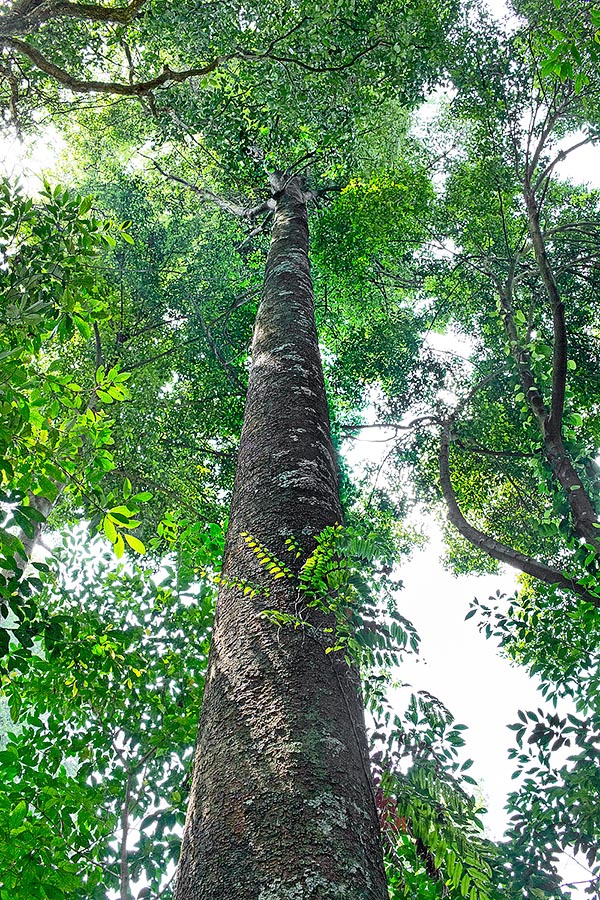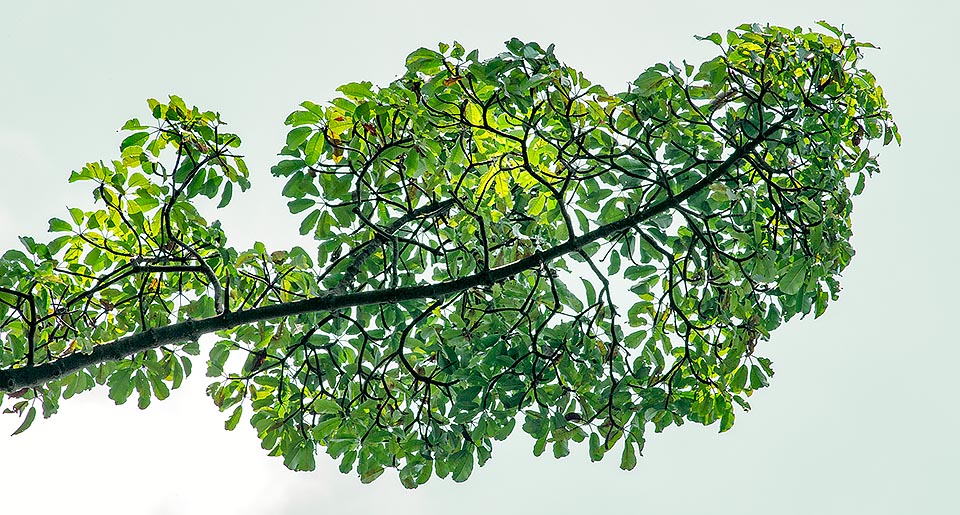Family : Apocynaceae

Text © Pietro Puccio

English translation by Mario Beltramini

A stately Dyera costulata in the Singapore pluvial forest. Evergreen or semi-deciduous species in the drought periods, can be 60 m tall with cylindrical trunk up to 1,6 m of diameter © Giuseppe Mazza
The genus is honoured to the English botanist William Turner Thistleton-Dyer (1843-1928); the specific name is the Latin adjective “costulatus, a, um” = endowed of small ribs, with reference to the veins of the leaves.
Common names: jelutong bukit (Malaysia); labuwai (Sumatra); lutong, teen-pet daeng (Thailand).
The Dyera costulata (Miq.) Hook.f. (1883) is an evergreen tree, or semi-deciduous in the drought periods, 30-60 m tall with cylindrical trunk up to 1,6 m of diameter, smooth dark grey bark with quadrangular scales and branches arranged in verticils; all parts of the plant contain a white latex that exudes abundantly from the wounds.
Simple leaves, arranged in verticils of 6-8, oblong-elliptic with entire margin, obtuse or slightly pointed apex and prominent veins, coriaceous, 5-30 cm long and 3-12 cm broad, glossy green above, greyish below; the new leaves are of bronze colour.
Axillar and terminal cymose inflorescences, on a 3-8 cm long peduncle, bearing numerous tiny flowers, that last one night only, with hemispherical calyx with 5 rounded lobes, white or yellowish green imbutiform corolla with 1-3 mm long tube and lobes 3-8 mm long and 1-2 mm broad.
The fruits are woody follicles in pair, 20-40 cm long and of 2,5-3,8 cm of diameter, dehiscent, covered by tiny scales of rust colour, containing numerous winged flat seeds, 5 cm long and 2 cm broad, wing included, dispersed by the wind.
It propagates by seed, that has a germinability lasting less than one year, previously kept in water for one day, in sandy loam maintained humid at the temperature of 24-28 °C; it reproduces also by cutting.
Imposing tree, fast growing as it can reach 10 m of height after 5 years from the planting, with particularly ornamental foliage, utilizable in parks and large gardens and as road tree in the tropical and humid subtropical climate regions; requires full sun and is not particular about the soil, provided well draining.
Besides its ornamental characteristics, it is cultivated, in its origin places, for the wood, that is in part exported, and utilized in the reforestation of degraded areas and in the consolidation of the soils.

Due to the fast growth and the ornamental leaves is often present in tropical gardens. In the past the latex was used for the chewing gum © Giuseppe Mazza
In the past, the latex has been utilized as component of the chewing gum, but it has been for a good part replaced by the Hevea brasiliensis one and by the synthesis products. The roots have been utilized as substitute for cork.
Synonyms: Alstonia costulata Miq. (1861); Alstonia eximia Miq. (1861); Alstonia grandifolia Miq. (1861); Dyera laxiflora Hook.f. (1882).
→ To appreciate the biodiversity within the APOCYNACEAE family please click here.
